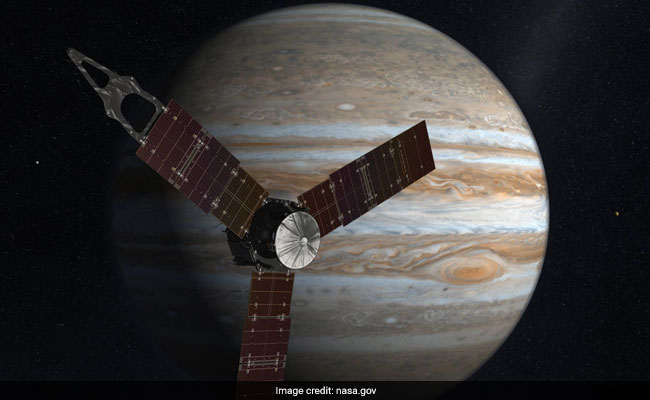Juno was launched on August 5, 2011, from Cape Canaveral, Florida, and arrived in Jupiter's orbit on July 4,2016.
Washington: NASA's solar-powered Juno spacecraft has successfully completed its eighth science flyby over Jupiter's mysterious cloud tops, the US space agency said today.
The confirmation of the flyby, performed on October 24, was delayed by several days due to a solar conjunction at Jupiter, which had affected communications during the days prior to and after the flyby, NASA said.
Solar conjunction is the period when the path of communication between Earth and Jupiter comes into close proximity with the Sun.

Juno's next close flyby of Jupiter will occur on December 16.
"All science instruments and the spacecraft's JunoCam were operating, and the new data are now being transmitted to Earth and being delivered into the hands of our science team," said Hirst.
Juno's next close flyby of Jupiter will occur on December 16.
"There is no more exciting place to be than in orbit around Jupiter and no team I would rather be with than the Juno team," said Hirst. "Our spacecraft is in great shape, and the team is looking forward to many more flybys of the solar system's largest planet," he said.
Juno was launched on August 5, 2011, from Cape Canaveral, Florida, and arrived in Jupiter's orbit on July 4, last year.
During its mission of exploration, Juno soars low over the planet's cloud tops - as close as about 3,400 kilometres.
Juno is probing beneath the obscuring cloud cover of Jupiter and studying its auroras to learn more about the planet's origins, structure, atmosphere and magnetosphere during these flybys.
Juno's next close flyby of Jupiter will occur on December 16.
"There is no more exciting place to be than in orbit around Jupiter and no team I would rather be with than the Juno team," said Hirst. "Our spacecraft is in great shape, and the team is looking forward to many more flybys of the solar system's largest planet," he said.
Juno was launched on August 5, 2011, from Cape Canaveral, Florida, and arrived in Jupiter's orbit on July 4, last year.
During its mission of exploration, Juno soars low over the planet's cloud tops - as close as about 3,400 kilometres.
Juno is probing beneath the obscuring cloud cover of Jupiter and studying its auroras to learn more about the planet's origins, structure, atmosphere and magnetosphere during these flybys.
Comments
Post a Comment